If you only knew of carnivorous plants thanks to the Venus Fly Trap, have a look at the Pitcher Plant. With an unusual appearance, they feature tubes or funnels that are actually traps for smaller animals and insects.
Even though they are carnivorous, growing pitcher plants as indoor houseplants is actually more common than you might believe. Growing them outdoors presents a greater challenge though.
- Related: Houseplant Guides
This guide covers how to care for pitcher plants and what they need to grow successfully.
Pitcher Plant Overview
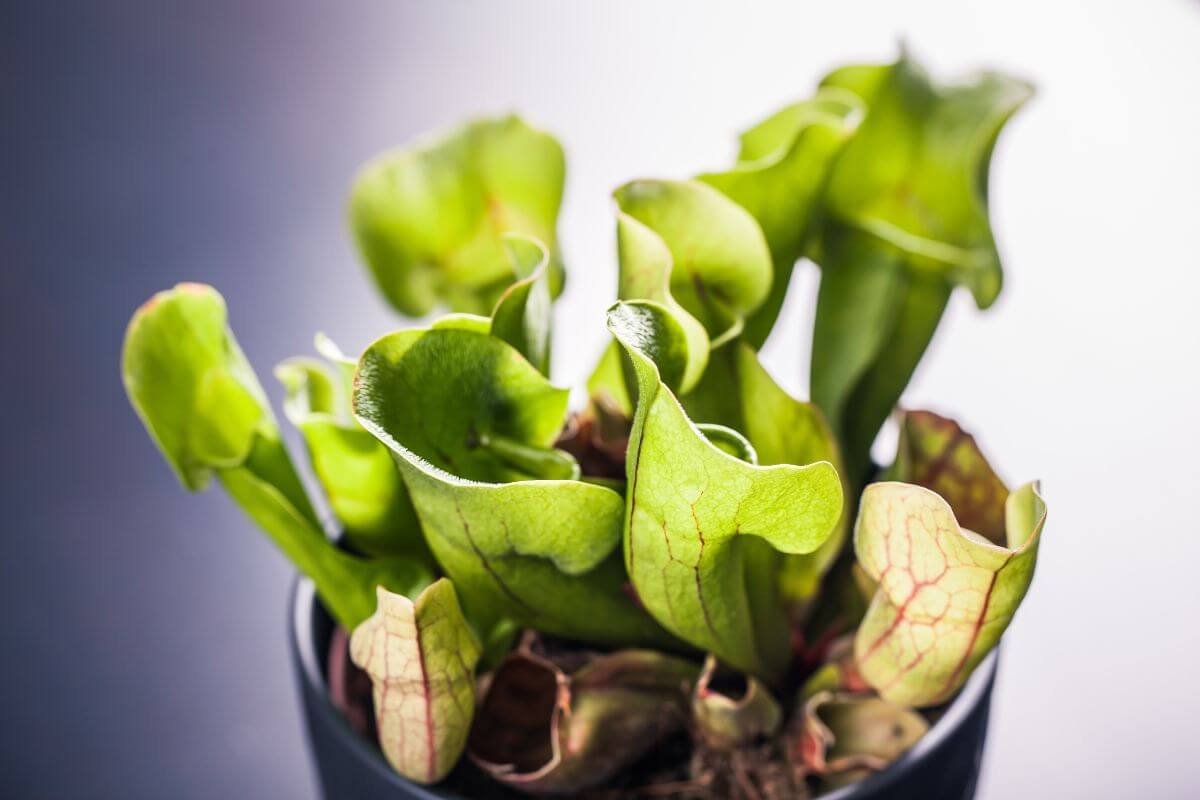
Pitcher plants are native to areas in Mississippi and Louisiana in the southern United States where soil beds are poor in nutrients. That means these plants must find food from sources other than soil.
The pitcher plant will secrete a nectary substance that acts as bait. After an insect enters the cup of the plant, digestive fluids will break down the insect into a nutritional soup that the plant feeds on.
There are many types of pitcher plants across five different genera:
- Sarracenia (North American) includes 8 species
- Nepenthes (Tropical) includes more than 160 species
- Heliamphora includes over 20 species
- Darlingtonia – one specie
- Cephalotus (West Australian) – one specie
Approximately eighty types of more well-known pitcher plants can be found cataloged with genus names Sarracenia, Darlingtonia, and Nepenthes.
Some can be grown outdoors, but not all. Nepenthes, for example, are tropical plants, while the Sarracenia purpurea, also known as the Purple Pitcher Plant, is exceptionally adaptable and can even be found growing in Canada. It does well in cooler regions.
Another type, the Sarracenia flava or Yellow Pitcher plant calls Texas and the bogs of Florida home. Together with the Sarracenia psittacine and Parrot Pitcher, both are plants that prefer warmer climates.
The Darlingtonia californica can be found in southern Oregon and northern California. Many of these species are difficult to grow, so if you decide to cultivate a pitcher plant, it should be a species that is adaptable to the region and climate where you reside.
The outdoor cultivation must include keeping the plants wet. The ideal outdoor growing condition is boggy, and both pond edges and bog gardens will provide you with a happy pitcher plant.
Indoor plants can be grown in just about any type of container or in a terrarium. Full sunlight or partial shade is necessary for successful growth.
Pitcher Plant Care Guide
If the environmental conditions are correct, the maintenance and care required are minimal.
Soil for the Pitcher Plant
The carnivorous nature and shape of this plant have developed due to the necessity to find nutrition from sources other than from soil.
The areas where they grow will be poor in nitrogen, so they capture insects to compensate.
If you decide to grow a pitcher plant outdoors, you will need to consider the location and the quality of the soil. These plants do not require rich soil, but it should be well-draining.
They prefer acidic soils and a peat-rich sandy combination is a good option. A well-draining soil that is low in nutrients, such as a mix with half sphagnum and half lava rock, vermiculite, or perlite.
You can also try a combination of sand, peaty soil, and sphagnum moss.
Light for the Pitcher Plant
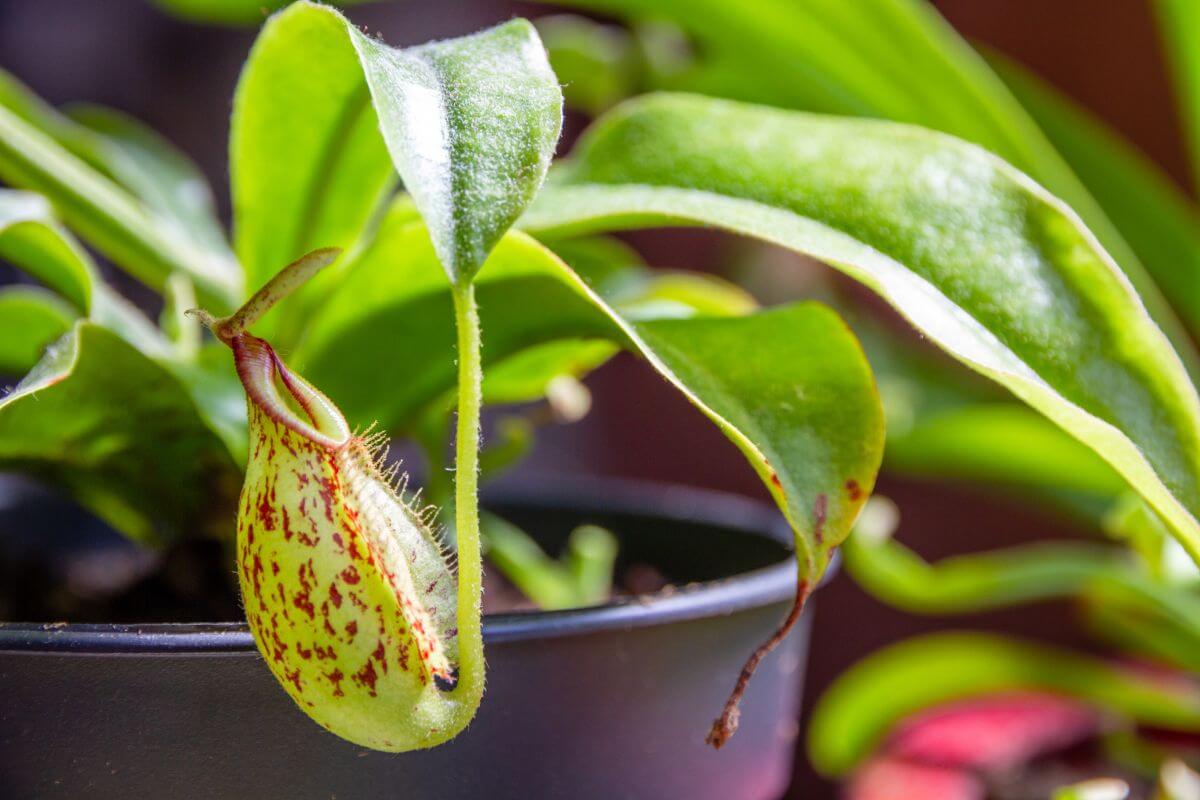
Pitcher plants need approximately six to eight hours of bright indirect light each day.
If leaves turn yellow, they may be getting too much light.
If the pitcher cups or leaves look floppy, they are probably not getting enough light.
Water and Humidity for the Pitcher Plant
Pitcher plants like moisture and humidity. Water the plant as soon as the soil bed feels even slightly dry.
Water not only the soil bed but water from the top, so leaves and pitchers receive moisture. Water your plant until it drips through the container’s drainage holes, allowing for thorough draining.
The plant should not sit in water though as they are prone to root rot.
Humidity levels should remain at 50% or above. If you place it in the midst of other plants, this will help increase the surrounding humidity.
A pebble tray underneath the plant can also be used as long as the pot bottom remains above the waterline of the pebble tray. A terrarium is also a humidity solution.
Water should be rainwater, filtered water, or distilled water. Hard tap water can contain too many minerals. If you use tap water, the plant will need to be flushed out with distilled water occasionally to eliminate mineral build-up.
Avoid placing the plants near air conditioners and heating vents as they tend to dry out the air.
Temperature for Pitcher Plant
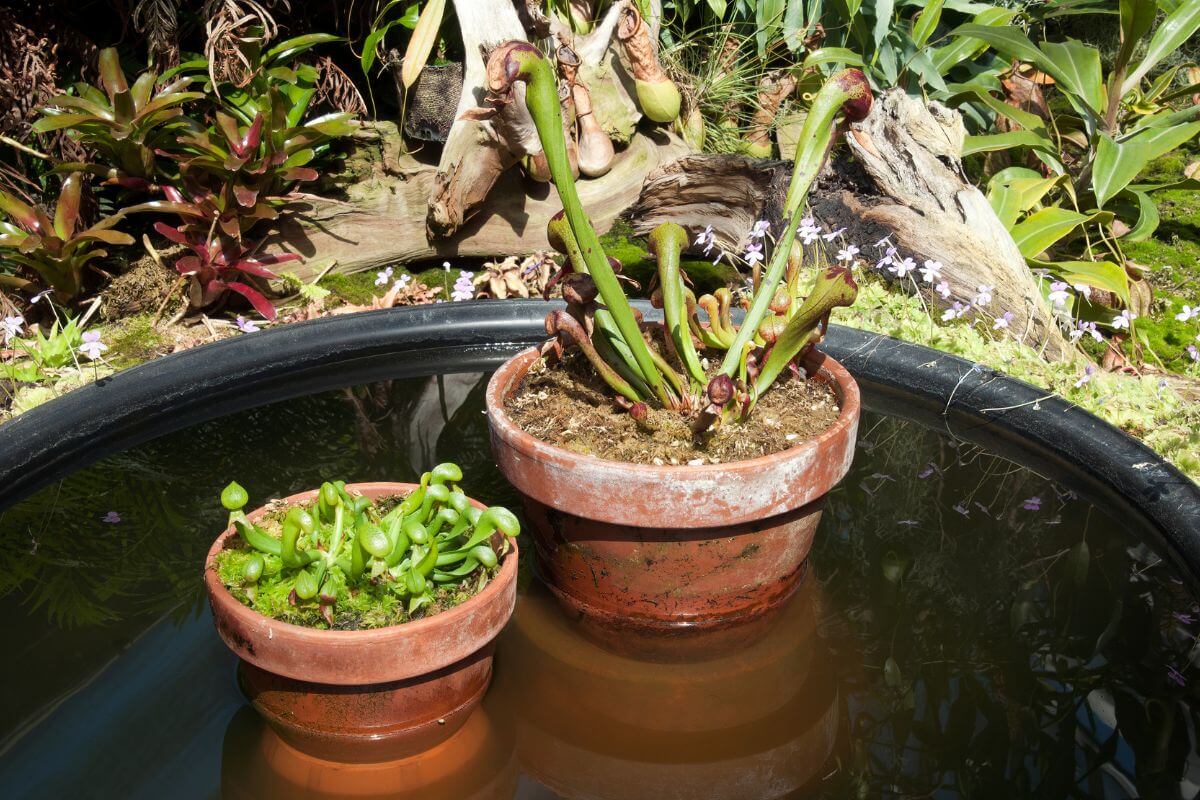
For the cultivation of indoor pitcher plants, the ideal temperature range will is 55° to 95° Fahrenheit. During the dormancy period, the temperature should be below 60°F.
Most pitcher varieties are not cold-hardy, so during winter dormancy, it will require extra care. These plants can survive a cold snap, but should be moved indoors or protected from cold weather during the winter.
The winter drop in temperature is necessary for dormancy. The arrival of warmer temperatures is a signal to the plant that dormancy has ended.
For very cold climates, if the plants need to be outside, mulch can be used at the plant base to help defend the roots. If your plants are growing outdoors in a bog garden or in water, make sure to break the ice and maintain full water trays.
The hardiest of the outdoor pitcher plants will be the Purple Pitcher plant. If you can offer controlled environmental conditions, such as in a greenhouse, most varieties will be fine with that.
Fertilizer for the Pitcher Plant
Fertilization for indoor pitcher plants should take place at the beginning of the growing season and continue monthly until the autumn months.
When growing indoors, you can fertilize with Orchid plant food (like this option online) is the best choice for fertilizing your pitcher plant.
If you are cultivating your pitcher plant outdoors, it will not require fertilization because it will catch insects and meet its nutrient needs in this manner.
But if you notice your pitcher plant looking yellow, it’s probably not harvesting sufficient insects.
You can give it a light feeding of acidic fertilizer. Use 1/8 teaspoon of acidic fertilizer in one quart of water. Be careful not to over-fertilize.
Pruning and Repotting the Pitcher Plant
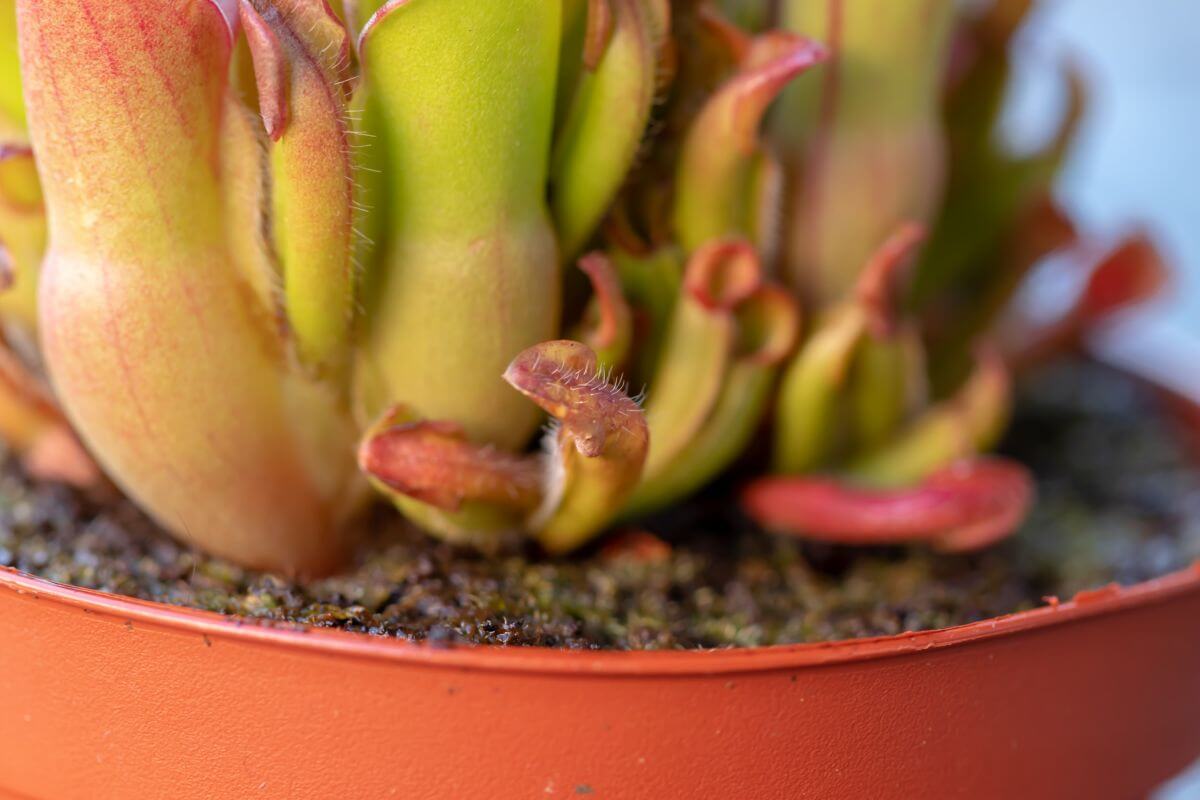
For the outdoor pitcher plant, leaves will drop naturally. When they die back, you can trim them off. New leaves will grow from the plant’s base.
Outdoor plants, however, do require protection from the ground freezing. This can be accomplished by mounding mulch at the base of the plant’s rosette.
If your plant blooms, prune the flowers once they wilt. Also, trim off any yellow or brown foliage. Cut the leaf just below the yellow part.
Repotting a pitcher plant should be done in the early spring. When the plant is still dormant, remove both the plant and soil bed as much as possible, and place it in a new pot.
Add in the new soil mix, covering the roots completely. Water to remove pockets of air and add mix as needed.
Propagating the Pitcher Plant
The best option for home gardeners to propagate a pitcher plant is with plant cuttings.
This plant will produce male and female flowers, but they must bloom at the same time in the hopes that male pollen will arrive in the female bloom. Seeds will require a great deal of time and good fortune, so cuttings are the quickest route to success.
Here’s how to propagate the pitcher plant with a plant cutting:
- It is best to cut a climbing stalk with a basal rosette. A stem below a lower sitting leaf with a bud is a good choice.
- You should count three nodes and cut.
- Place your cutting in water covering the end and first node.
- The water should be rainwater or distilled. Place the glass holding the cutting in a warm temperature location with bright indirect light.
- Water should be changed weekly.
- Within two weeks, the stem will split, producing tiny roots.
- When at least six roots have formed, transfer the cutting to sphagnum moss and keep it moist.
- After approximately six months, the plant will develop into a typical pitcher plant.
- Watch for root rot or fungus on your cutting.
Pitcher Plant Toxicity and Pets
Pitcher Plants are non-toxic to dogs, cats, and horses. There’s no poisoning concern with the tropical pitcher plants.
Pitcher Plant Pests, Diseases, and Problems
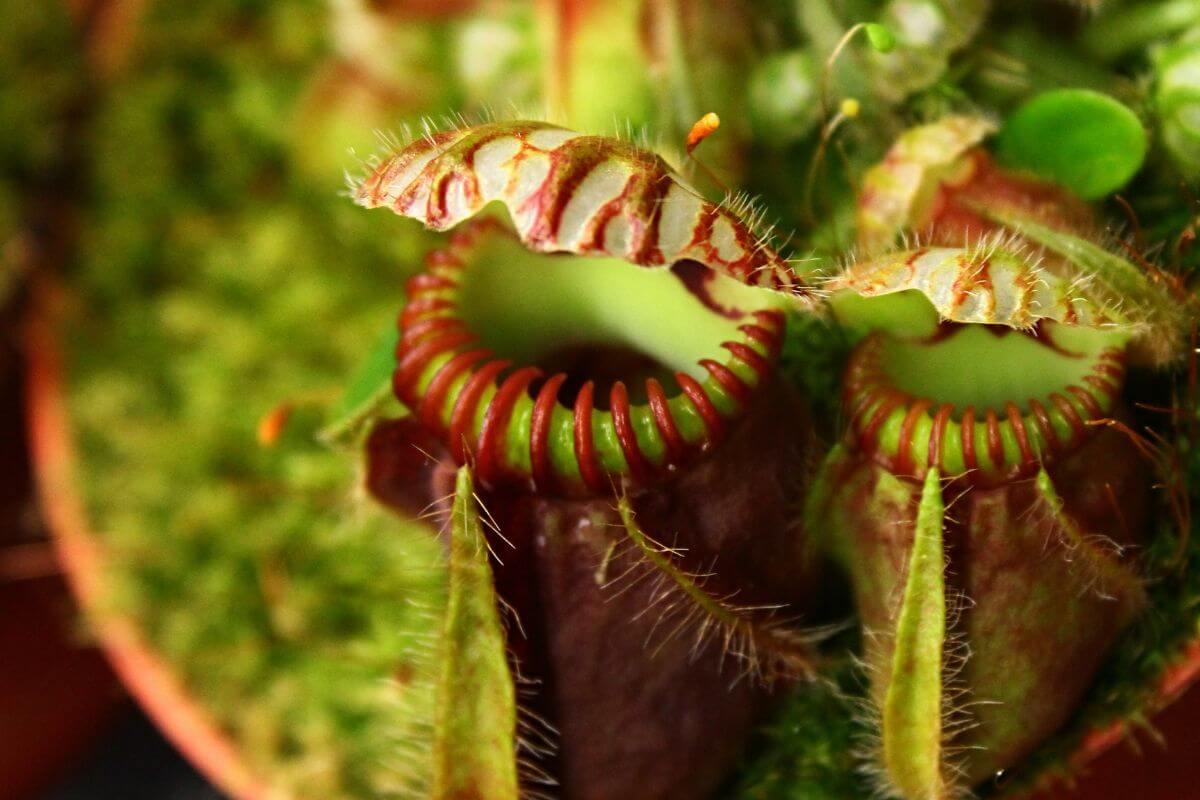
The main problems for pitcher plants begin with the environment. Plants subject to outdoor freezing, need a mulch blanket. If the freeze comes before the plant is dormant, it may kill the plant.
As a bog plant, the soil must be well-draining. Clay-based soil may drown the plant, so it is best to avoid it Chemical pesticides are also dangerous for pitcher plants.
For indoor plants, direct soil fertilization can encourage fungal disease which will destroy the roots and vascular system of the plant. Fertilizer diluted in water will help avoid these infections.
Pests that threaten the pitcher plant include spider mites. Keeping the plant moist will assist in prevention. Thrips will cause the leaves to deform, while aphids, mealybugs, and leafhoppers, can ruin the plant.
To get rid of pests, neem oil is effective, as well as specific products along with water rinses.
For indications of any issues with the pitcher plant, check the coloration of the leaves.
Black leaves on a pitcher plant will indicate shock of some kind to the plant. Check light, water, and feeding amounts and any sudden changes to them.
Red leaves on a pitcher plant may signal a problem or be normal. If new leaves are tinged red, this implies that it is normal for the plant. If mature leaves turn red, it may be an indication of too much sunlight or too little phosphorous in their diet.
Pitcher Plant Care Final Thoughts
With leaves that are shaped like vases, these carnivorous plants are quite fascinating to cultivate whether indoors or outdoors.
With the correct environmental conditions, pitcher plants require little care and will be an interesting addition to a home garden, terrarium, or outdoor pond on your property.
For more carnivorous plants and other houseplant guides, check these out:
- Venus Fly Trap Care Complete Guide
- Pilea Plant Care Complete Guide
- Shamrock Plant Care Complete Guide
Pitcher Plant Care FAQs
Can you grow pitcher plants indoors?
Yes, you can grow pitcher plants indoors. In fact, it’ll be easier to grow indoors than outdoors, because you can control the environment better – lights, water, humidity, and nutrient levels.
How do you take care of a pitcher plant?
Pitcher plants need acidic, well-draining soil, bright indirect light and high humidity. They should be watered when the soil starts to feel dry. Prune away dead, yellowing, and brown leaves and tips.
Can a pitcher plant eat a human?
No, you don’t need to worry because the pitcher plant won’t eat a human. If you put your finger in the plant’s cup, it will close around your finger, but won’t eat your finger. But you could potentially harm the pitcher plant and damage its ability to feed on insects in the future.
What does a pitcher plant eat?
The pitcher plant eats small animals such as flies, ants, beetles, spiders, crickets, grasshoppers, caterpillars, worms, snails, slugs, centipedes, and millipedes. Its cups are traps for insects and as the plant catches insects, its digestive fluid with break down the insects for nutrients.
Should you fill pitcher plants with water?
Yes, you can fill the pitcher plants with water if you want. It doesn’t matter how often you add water; just make sure not to overfill the pitchers. Also use distilled water instead of tap water. Keep some water in the pitchers will also help good bacteria grow and populate to keep it healthy.
Can you drink pitcher plant water?
Yes, you can drink pitcher plant water if you want. The water in there will be the water you pour in or any rainwater its caught. There will also be the digestive fluids that the pitcher plants use to break down insects for nutrients. The digestive substances won’t hurt humans.
What is the natural habitat of the pitcher plant
The natural habitat of the pitcher plant is in North America’s tropical forests and boggy areas. They like humid areas like wetlands with lots of standing water. Areas with lots of bright indirect light is also preferred.


